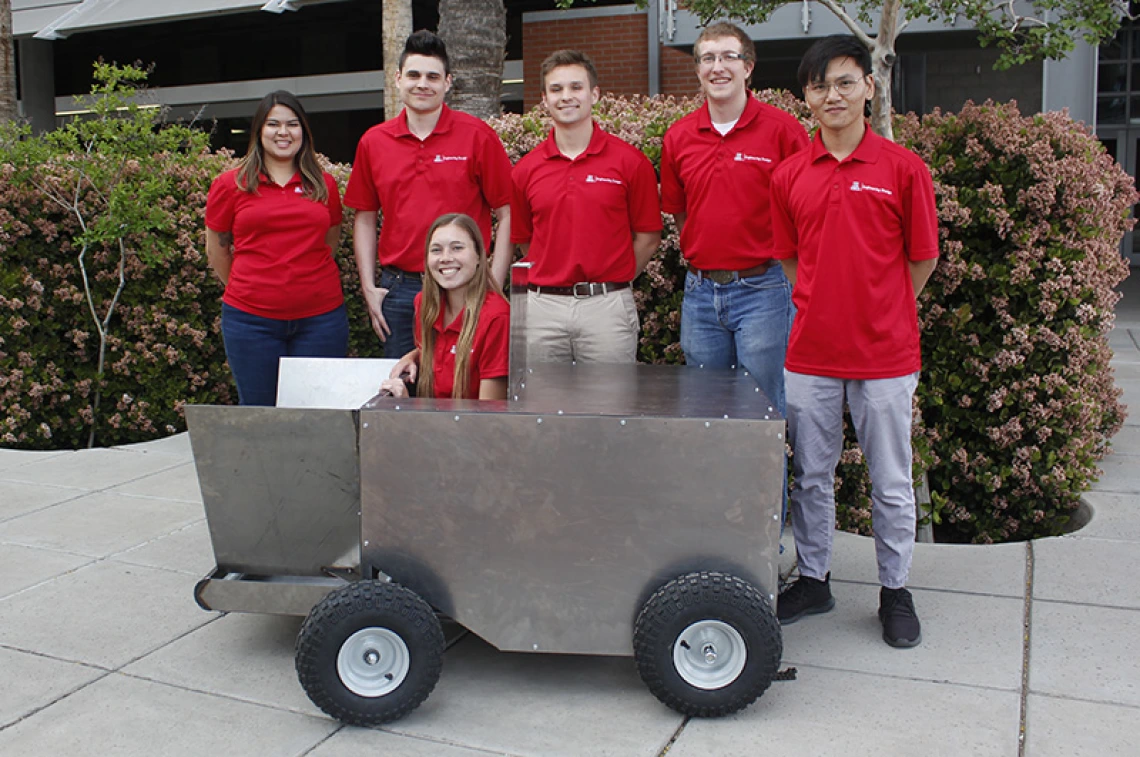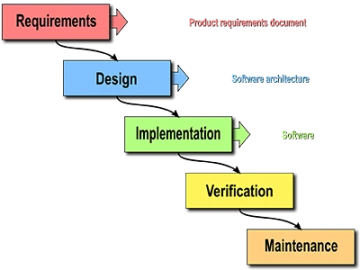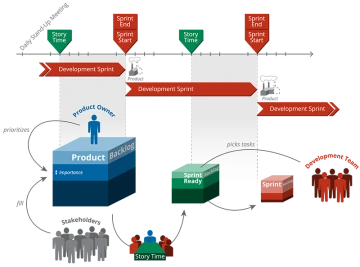Capstone Students Get Agile
Engineering seniors to deliver value to sponsors more quickly by implementing flexible project management technique.

Team 18025, sponsored last year by professor of entomology Goggy Davidowitz, gather around their grasshopper harvester prototype. The 2019-2020 team will use Agile process to guide their harvester design.
University of Arizona Interdisciplinary Capstone instructors Cat and Claude Merrill are teaching 13 teams of seniors – a subset of the more than 100 teams planning to display their projects at Craig M. Berge Design Day 2020 – a form of project management called Agile process, or simply Agile, in the 2019-2020 academic year.

The Waterfall method of project management, in which specifications are fully developed before building begins. (Credit: Wikimedia)
Historically, all University of Arizona engineering capstone projects have used the traditional Waterfall method, in which engineers create specifications and designs for the entire project before building, testing and verifying the product.
In Agile process, engineers use customer input to focus on a specific element of a project that will bring the most value to the customer, and then design, validate and implement – and, if necessary, revisit and improve upon – that piece before moving onto the next one.
Agile is becoming increasingly popular in industry, particularly for software projects, although the Waterfall method is still widely used. The Merrills carefully selected the 13 projects using Agile methodology this year as ones that could most benefit from the process.

In Agile process, engineers construct versions of a product in sprints, with the primary stakeholder prioritizing a minimum viable product.
Wikimedia
“The idea behind Agile in general is you very quickly give value to your customer,” Cat said.
Cat, who also works as a systems engineer on the University of Arizona-led OSIRIS-REx asteroid return mission and as a program manager at the Lunar & Planetary Laboratory, worked with Agile during her time at the National Optical Astronomy Observatory, now the National Optical-Infrared Astronomy Research Laboratory. She and Claude both spent years at Raytheon, where they used both Agile and traditional methods.
While the teams they’re working with are using the Agile approach for their senior capstone projects, the students are learning the traditional method as well, so they’ll know how to apply either, depending on a given project’s needs.
Requirements Versus Desires
Agile requires sponsors to define their minimum viable product, or MVP, early in the process, so teams can focus their effort in the most critical area before moving on to others.
“In the traditional method, you have a lot of margin in what sponsors are requesting,” Cat said. “They might need a box to be 4 by 6 inches, but they request larger, just in case. Agile helps the sponsors and teams identify what is truly a requirement and what is a desire.”
Claude gave the example described in “Agile Project Management for Dummies” of a software developer creating an online store for a customer. While setting up the ability to accept Visa, Discover, Mastercard and PayPal would take a full year, accepting Visa payments would take just two months. Using Agile process, and identifying accepting Visa payments as the MVP, allowed the shop to make millions of dollars in sales by the time a year had passed and all desired payment systems were in place.
In Interdisciplinary Capstone, a team is building a grasshopper harvester to remove pests from agricultural fields for sponsor Goggy Davidowitz from the Department of Entomology. Design requirements include remote steering capabilities, a conveyer to move grasshoppers from the collector tray to a storage bin, and a system to wirelessly send status updates to a central computer.
But the most important part, according to the sponsor? The ability to capture grasshoppers! With this MVP in mind, the team is tackling the capture mechanism before addressing other elements of the project.
Sprinting on Track
Another benefit to Agile process is that its iterative nature forces teams to check in on their progress more frequently than traditional methods, making them more responsive to change. There are a number of ways to do Agile, but Cat and Claude are using a particularly structured version in this instructional setting. Students are required to complete sections of work in two-week chunks called sprints.
“Every two weeks, teams should be able to assess whether they’re on track,” Cat said. “So, even if they deviate, at the end of two weeks, they can get back on course.”
Whether they’re designing devices to catch grasshoppers or detect epileptic seizures, University of Arizona engineering students using Agile for their senior projects will learn a flexible process for producing value. And, when the MVP is delivered and their capstones are completed, they’ll be armed with skills to help them find success in the modern workforce.

